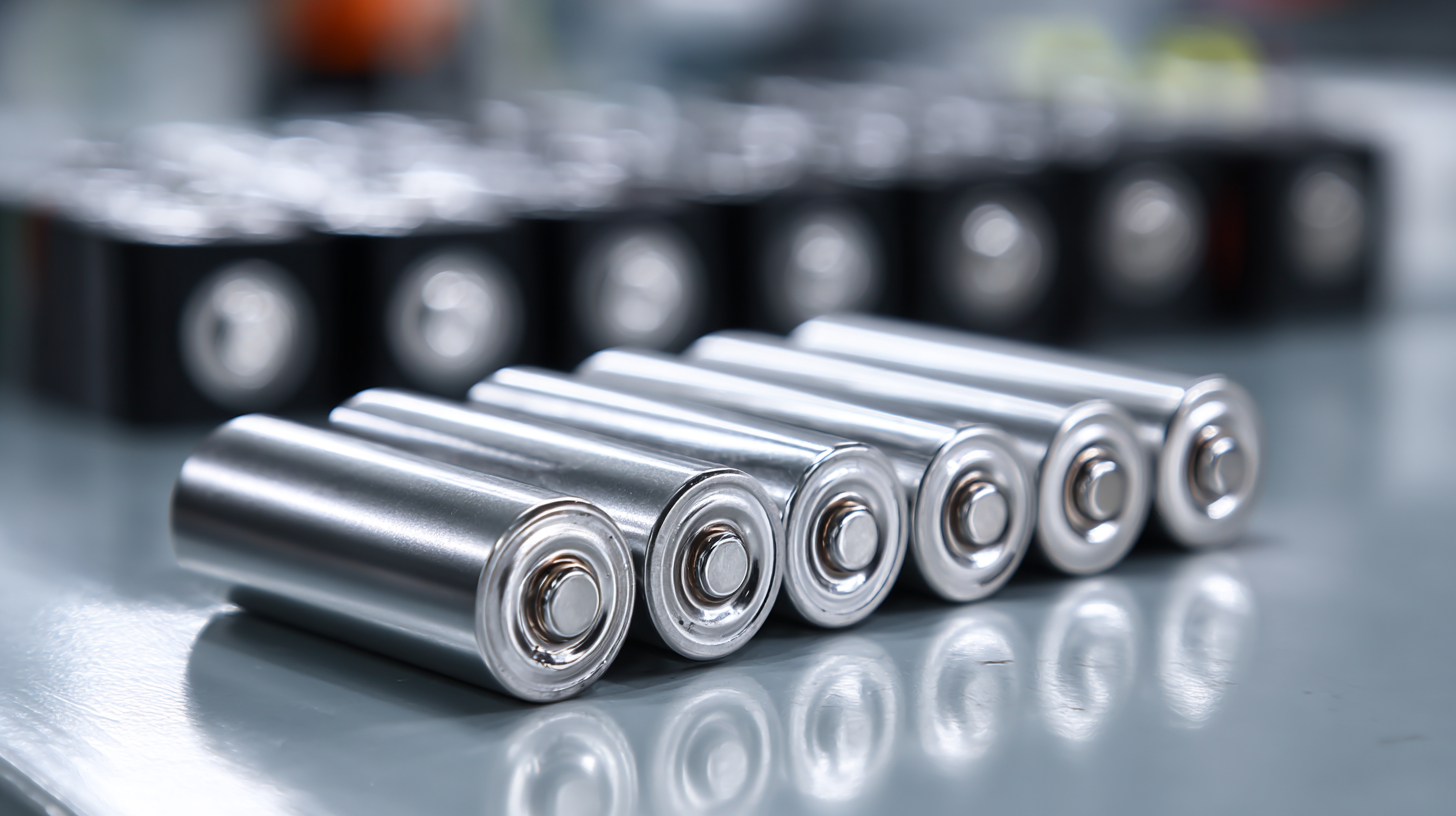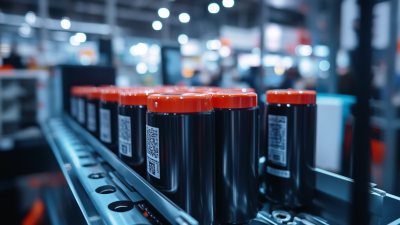Leave Your Message
In the evolving landscape of modern energy solutions, the significance of the 26650 Cylindrical Battery Pilot Line cannot be overstated. As the demand for high-capacity energy storage systems grows, particularly in sectors such as electric vehicles and renewable energy, the 26650 cylindrical battery format has emerged as a pivotal player. According to a recent report by Market Research Future, the global cylindrical lithium-ion battery market is expected to reach a staggering USD 48.55 billion by 2025, driven largely by advancements in battery technology and the integration of pilot lines to streamline production processes. These pilot lines are crucial for ensuring the quality and efficiency of battery manufacturing, ultimately impacting performance and safety standards across applications. Thus, investing in a dedicated 26650 Cylindrical Battery Pilot Line represents a strategic move towards enhancing energy solutions for a sustainable future.

The 26650 cylindrical battery has emerged as a pivotal component in modern energy storage systems, largely due to its high energy density and extended lifecycle. These batteries are particularly valued in applications ranging from renewable energy storage to electric vehicles, providing a reliable solution to the increasing energy demands of today's world. Their robust design allows for higher capacities than traditional batteries, making them ideal for powering larger systems and reducing the frequency of replacements.
Tips for maximizing the performance of 26650 cylindrical batteries include proper temperature management. Keeping batteries within the recommended temperature range can greatly enhance their efficiency and lifespan. Additionally, ensuring that the batteries are charged and discharged at appropriate rates helps maintain optimum performance and prevents damage. Lastly, regular monitoring of battery health can aid in identifying potential issues before they lead to failures, ensuring a steady energy supply.
The significance of 26650 cylindrical batteries extends beyond their physical attributes; they are essential for the sustainability of energy solutions. As the world shifts towards greener alternatives, these batteries play a vital role in stabilizing renewable energy sources and allowing for a more adaptable energy grid. By investing in and utilizing 26650 technology, industries can contribute to a more sustainable future while reaping the benefits of enhanced energy independence.

The 26650 cylindrical battery is rapidly becoming a cornerstone in modern energy solutions, particularly due to its unique combination of features and advantages. One of the standout characteristics of this battery type is its high energy density, which allows for longer usage times without significantly increasing size or weight. This makes it an ideal choice for applications ranging from electric vehicles to renewable energy storage systems, where efficiency and space-saving are paramount.
Another significant advantage of the 26650 format is its robust performance under various temperatures and conditions. These batteries can deliver stable voltage over a wide range of operating temperatures, making them suitable for both indoor and outdoor applications. Furthermore, their cylindrical shape enhances structural integrity while promoting better heat dissipation, reducing the risks of overheating—a critical factor for safety in high-demand environments. With its combination of high capacity, durability, and safety, the 26650 cylindrical battery is poised to play a crucial role in driving forward modern energy solutions.
The importance of pilot lines in battery production efficiency cannot be overstated, especially as the demand for advanced energy solutions surges. Recently, several manufacturers have unveiled pilot lines focused on enhancing their battery technologies. For example, one company is establishing a pilot line for unidirectional prismatic battery cells, aiming to streamline production and meet increasing market demands efficiently. Such initiatives reflect a growing recognition of pilot lines as critical components in the journey from concept to mass production.
Moreover, another company has successfully launched a 0.2GWh pilot production line for all-solid-state batteries with an impressive 90% yield rate. This achievement showcases the potential pilot lines have in optimizing manufacturing processes and ensuring high-quality outputs. By refining production techniques and testing new technologies at these pilot facilities, companies can effectively pivot towards mass production, mitigating risks associated with scaling their operations. As industries continue to innovate, the role of pilot lines will remain pivotal in driving the advancement of battery technologies and contributing to sustainable energy solutions.
The 26650 cylindrical battery is rapidly gaining traction in various modern technological applications due to its superior energy density and performance. These batteries are increasingly favored in electric vehicles (EVs), with reports from the International Energy Agency indicating that EV sales surged past 6 million in 2021 alone, largely propelled by advancements in battery technology. The 26650 battery, with its capacity to deliver over 5000mAh, offers extended range and performance for EVs, crucial in addressing consumer demands for longer-lasting power sources.

In addition to the automotive sector, 26650 batteries are finding their way into renewable energy storage solutions. A report from MarketsandMarkets highlights that the global energy storage market is projected to grow from $12.1 billion in 2020 to $28.6 billion by 2025. As energy solutions become more decentralized, high-capacity batteries like the 26650 are essential for storing renewable energies such as solar and wind, enabling more efficient energy management. Furthermore, with their robust design, these batteries are ideal for industrial applications, providing reliable power for machinery and heavy equipment, thereby playing a critical role in enhancing productivity and sustainability in modern industries.
The evolution of battery technologies has been nothing short of revolutionary, significantly impacting various sectors from consumer electronics to renewable energy. In recent years, the 26650 cylindrical battery has emerged as a key player in this landscape, known for its high capacity and extended cycle life. These batteries are increasingly being adopted in applications that require robust power solutions, such as electric vehicles and large-scale energy storage systems. Their design not only maximizes energy density but also enhances safety, making them a favorable choice for modern energy solutions.
Looking ahead, the future trends in battery technologies suggest a move towards even more advanced designs and materials. Innovations such as solid-state batteries and improved lithium-ion chemistries are on the horizon, promising greater efficiencies and faster charging times. Furthermore, the growing focus on sustainability is pushing manufacturers to explore eco-friendly alternatives that minimize environmental impact. As the demand for reliable and efficient energy storage grows, the importance of pilot lines for developing next-generation battery technologies, like the 26650, will be crucial in shaping the future of energy solutions.
| Dimension | Details |
|---|---|
| Battery Size | 26mm diameter, 65mm height |
| Capacity | Up to 6000mAh |
| Nominal Voltage | 3.7V |
| Energy Density | Approximately 250Wh/kg |
| Cycle Life | Over 500 charge cycles |
| Applications | Electric vehicles, power tools, energy storage systems |
| Charging Time | 4-6 hours with fast charger |
| Environmental Impact | Low due to lifecycle recycling capabilities |






